Growing Up in Scotland: father-child relationships and child socio-emotional wellbeing
Research report providing insight into the nature of father-child relationships in Scotland.
Chapter 5: Early Predictors Of Poor Father-Child Relationships
5.1 Introduction
This section investigates which family circumstances in early childhood may affect the development of the ten year-old child's relationship with the resident biological father. The analysis draws on earlier sweeps of GUS BC1 data from sweep 1 (child aged 10 months) to sweep 7 (child aged 8), as well as a "between sweep" web and telephone survey conducted when children were 9 years old. It makes particular use of information from a partner questionnaire administered to fathers residing with the mother and child at sweep 2, when children were aged approximately two years old. This questionnaire is a unique GUS source of resident fathers' own reports of involvement in parenting, relationship with the mother and mental health.
The analysis sample for this section is a subset of the main analysis sample used elsewhere in the report, and consists of 1,967 families where the biological parents and child all lived together from the baseline survey (child aged 10 months) until the child was approximately 10 years old. The father completed a partner questionnaire when the child was aged 2 in 1,648 (84%) of these families.
The analysis is divided into two stages. The first stage is an investigation of influences on father-child relationships from early childhood (infancy and toddlerhood), using information from the 10-month and 2 year interviews. The second stage considers some additional child characteristics, aspects of parenting and the family climate from pre-school and school age years, using information from the age 4, 5 and 8-year interviews, and the age 9 web/telephone survey. All pre-school/school age information was gathered from the child's main carer (in the great majority of cases, this was the child's mother) and (at age 8) from the child directly.
As in the previous section 4.6, multivariable models were used to ascertain key independent predictors of a poor father-child relationship. Two models were constructed. The first considered early childhood factors, and the second added pre-school and school-age factors.
5.2 Key findings from multivariable models
- Early childhood risk factors for a poor father-child relationship are low family socio- economic status, a poor partner relationship, the father working as a small employer or own account worker (i.e. self-employed) and the family living in a remote part of Scotland
- Pre-school and school-age risk factors for a poor father-child relationship are adverse family events, weak family organisation, a less supportive family ethos and low levels of positive parenting
- Poor father-child and mother-child relationships share common early risk factors (low family socio-economic status, poor partner relationship) and later risk factors (adverse family events, low levels of positive parenting)
- Father-child relationships appear to be more affected by aspects of family climate than mother-child relationships
5.3 Potential influences on the father-child relationship from infancy and toddlerhood
This section considers how early child and family characteristics and circumstances, together with fathers' health, relationship with the mother and involvement in parenting, may help shape the quality of the father-child relationship when children are ten years old.
5.3.1 Early child characteristics
Parenting a child with poor health or developmental problems may present significant challenges. Nevertheless, none of the indicators of health or developmental problems in infancy and toddlerhood examined for this report (low birth weight, developmental delay at age 2, limiting long term illness at 10 months or age 2) is associated with the quality of the father-child relationship at age 10.
5.3.2 Family characteristics and circumstances
Several early family characteristics (whether one or both parents from a minority ethnic group, both parents' ages when their child was born, the number of children in the family, adverse family events such as illnesses and deaths) are not associated with later father-child relationships. The lack of an effect of mother's age for this more restricted sample of families with both biological parents contrasts with the simple association found between mother's age and risk of poor father-child relationship for the larger sample of couple families (see section 4.4). This difference may be explained by the fact that families where there is a mother under 29 years are much more likely to contain a non-biological father figure by the time the child is ten years old (39% did so, compared to 10% of the total sample).
Couple marital status had a slight association (borderline probability, p=0.07): among fathers who were not married to the child's mother at the 10 month baseline, 17% had a poor father-child relationship at age 10, compared to 14% of married fathers.
However, various indicators of family socio-economic disadvantage in early childhood are more clearly associated with a greater likelihood that the ten year-old child would have a poor relationship with the father. These indicators include the father's and the mother's level of educational qualifications, household income, and the father's employment status and occupation.
Among families where the father had few or no educational qualifications, 21% of children have a poor relationship compared to 11% of families where the father was educated to degree level (Figure 5-A). The graph shows an even stronger association between mothers' educational level and father-child relationship quality.
Figure 5-A Associations between parental educational level and father-child relationship quality
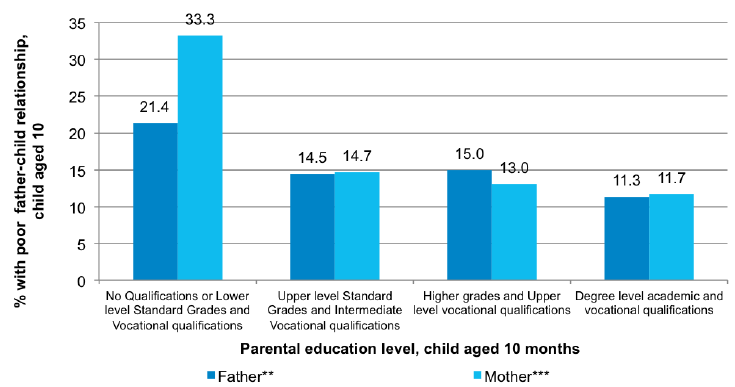
Note: Base sample of couples with both biological parents n=1,967 (unweighted). Asterisks indicate statistically significant (linear) associations between educational level and poor father-child relationship, ** p<0.01, *** p<0.001.
Although household income when the child was 10 months old did not show a clear association with later father-child relationship, a stronger trend emerged for income by the time the child was almost two years old (Figure 5-B). There was a two-fold difference across income quintiles at this age, with 21% of those in the lowest quintile having a poor relationship compared to 11% in the top income quintile. This was similar to the difference found across levels of fathers' education.
Figure 5-B Associations between household income and father-child relationship
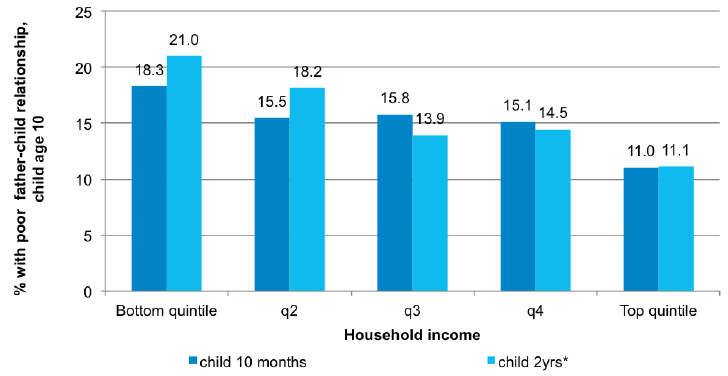
Note: Base sample couples with both biological parents n=1,967 (unweighted). Household income is equivalised to take account of household size and composition. Asterisk indicates statistically significant associations between household income and poor father-child relationship, * p<0.05.
Parental employment status is an indication of socio-economic disadvantage, but might also signal availability for parenting the child. Fathers who were unemployed when their child was aged 2 were twice as likely to have a poor relationship with their ten year-old child compared to fathers working full time (Figure 5-C). There was no clear association between mothers' employment status and the quality of the father-child relationship. Further investigation also suggested no clear patterning of father-child relationships according to whether the father or mother was the main breadwinner, or both parents shared this role at child aged 2.
The finding for fathers' unemployment appears to reflect lower family income, rather than availability, as unemployed fathers were most likely to say they had "plenty of time" to spend with their child [6] . Further examination of working hours among employed fathers, when the child was aged 2, did not suggest a clear association with later father-child relationship quality, even for fathers exceeding the EU maximum threshold of 48 hours per week [7] .
Figure 5-C Associations between parental employment and father-child relationship
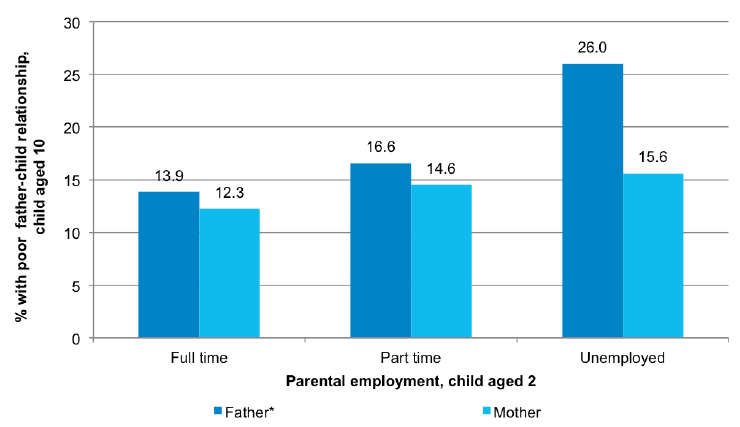
Note: Base sample of couples with both biological parents n=1,967 (unweighted). Asterisk indicates statistically significant association between father's employment status and relationship with child, * p<0.05.
The last potential family-level indicator of socio-economic disadvantage considered here is parental occupational class. In the analysis sample for this section, the largest occupational class was professional/managerial (46% of fathers, and 42% of mothers, when children were 2 years old). Compared with this group, fathers who were small employers/own acccount workers, or who were in semi routine/routine occupations were significantly more likely to have a poor relationship with the ten year-old child (Figure 5-D). Other occupational classes were not significantly different from the professional/managerial class. The National Statistics Socio-economic Classification ( NS-SeC) system used to classify parental occupation here does not represent a completely linear hierarchy.The finding for routine occupations might signal an impact of low income, but an explanation for the effect of being a small employer/ own account worker is likely to be more complex and reflect other characteristics of this type of occupation.
Very few mothers were small employers/own account workers when their child was two years old (only 6%, compared to 13% of fathers in this class). For mothers, this occupational class did not differ from professional/managerial workers in respect of father-child relationships. Nevertheless, worse father-child relationships compared with the professional/ managerial class were found for the other occupational groups (borderline, p<0.1 difference for lower supervisory/technical, Figure 5-D). This might suggest an effect of lower income.
Figure 5-D Association between parental occupational class and father-child relationship
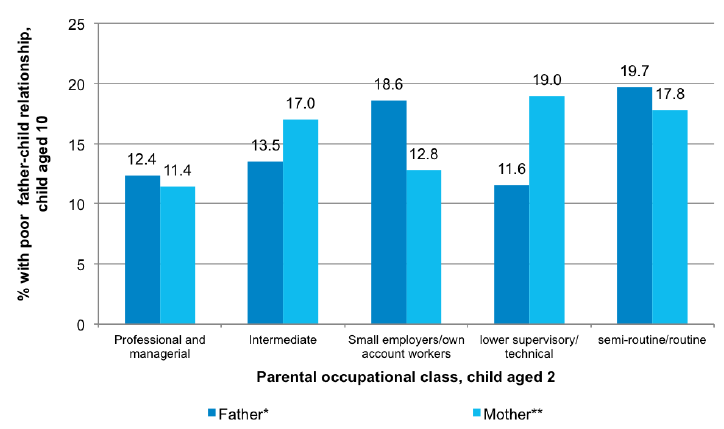
Note: Base sample n=1967 (unweighted). Occupation based on National Statistics Socio-economic Classification ( NS-SeC) six-fold classification, excluding "never worked". Asterisks indicate significant (linear) associations between occupational class and father-child relationship where * p<0.05, ** p<0.01.
Lastly, we considered two aspects of home location: neighbourhood deprivation and urban- rural location. Neighbourhood deprivation, measured using the Scottish Index of Multiple Deprivation linked to families' home postcode when the child was 10 months old did not show an association with father-child relationship quality (Figure 5-E). There was no clear difference in father-child relationship quality according to whether families lived in an urban or rural location. However, living in a geographically remote part of Scotland (more than 30 minutes' driving time from urban settlements of 10,000 people or more), did appear to increase the risk of a poor father-child relationship, irrespective of whether the family was living in a remote town or rural area. When these two area categories were combined, the risk of a poor relationship was 20%, compared to 14% in other areas (urban or accessible): this difference was statistically significant ( p<0.05).
Figure 5-E Associations between home location and father-child relationship quality

Note: Base sample of couples with both biological parents n=1967 (unweighted).
5.3.3 Fathers' mental health, partner relationship, work-life balance and parenting
In this section, we use information gathered directly from fathers when their child was aged 2 years to assess whether fathers' mental health, relationship with the mother, work-life balance and early involvement in parenting may shape their later relationship with the child.
Mental health
Fathers reported on their stress and depression using subscales of the short-form Depression Anxiety and Stress Scales ( DASS) (Henry & Crawford, 2005). Fathers were classified as reporting either "high stress" or "depression" if the relevant scores were more than one standard deviation from the mean in the direction of poor mental health. High stress was found in 10% of fathers, and 19% were classified as reporting depression.
However, there is no clear association between either measure of mental health and later father-child relationship quality (Figure 5-F).
Partner relationship
Fathers and mothers both reported on the quality (support) of their relationship with each other using seven items. These were: "My (partner) is usually sensitive to and aware of my needs", "My (partner) doesn't seem to listen to me", "I sometimes feel lonely even when I am with my (partner)", "I suspect we may be on the brink of separation" (all with a 5-point response scale, from (1) strongly agree to (5) strongly disagree); together with two items about conflict: "How often do you and your partner argue?" and "How often is there anger or hostility between you and your partner?" (both items with a 3-point response scale: (1) more than once a week (2) once a week or less (3) not at all). Items showed good internal reliability (Cronbach alphas for standardised items were fathers 0.72, mothers 0.75), and so were combined to give a mean score for each parent. An average of the mother and father scores was calculated, and banded into tertiles to indicate high, medium and low partner support.
Fathers from families where the parents enjoyed a good relationship with each other (high support) are around half as likely to have a poor father-child relationship as those with a poor quality relationship (low support) - see Figure 5-F.
Figure 5-F Father mental health and partner relationship quality: associations with father-child relationship
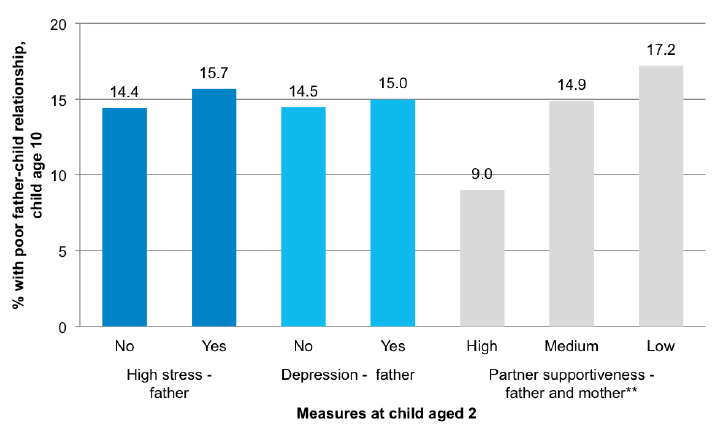
Note: Base sample of couples with both biological parents and completed partner questionnaire n=1,648 (unweighted). Asterisks indicate statistically significant association between partner supportiveness and poor father-child relationship,
** p<0.01.
Work-life balance
Most fathers (95%) were in employment when their child was two years old. At this time, working fathers' views on whether they had a favourable work-life balance, in terms of little impact of work on family life (or vice-versa) were measured using four items. These items all loaded on to the same underlying factor and showed good internal reliability (standardised Cronbach alpha=0.64). Items concerned views on the amount of time available to spend with their child (coded on a 4-point scale from "nowhere enough time" to "plenty of time"); and agreement with three statements: "Because of my work responsibilities I have missed out on home or family activities that I would like to have taken part"; "Because of my work responsibilities my family time is less enjoyable and more pressured"; "Because of my family responsibilities the time I spend working is less enjoyable and more pressured" (all measured using a 5-point scale from "agree strongly" to "disagree strongly"). Average scores were divided into tertiles indicating poor, medium and good work-life balance.
Figure 5-G shows that there is no clear association between fathers reporting a poor work-life balance when the child was 2 years old and the likelihood of a poor father-child relationship eight years later.
Figure 5-G Association between father's work-life balance and father-child relationship
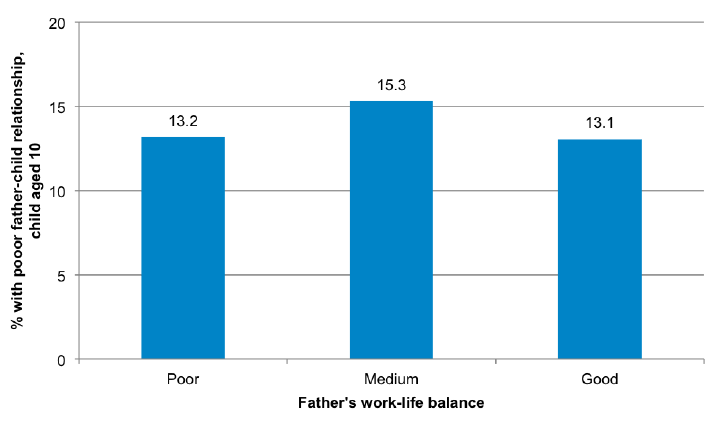
Note: Base sample of couples with both biological parents and completed partner questionnaire n=1,648 (unweighted).
Fathers' involvement in parenting
Fathers reported on various aspects of parenting the two-year old child: these were involvement in play and routine care, reading to the child, and use of positive and negative discipline methods.
Involvement in play was measured using three items concerning how often the father played with, talked to and cuddled the child. Involvement in care was measured using three items concerning how often fathers bathed the child, dressed the child and put the child to bed.
Reading to the child was a single item. Responses were all on a 5-point scale (1) less than once a week (2) once or twice a week (3) a few times a week (4) once a day (5) more than once a day. Items for play and routine care had good reliability (Cronbach alphas respectively 0.72 and 0.65) and were combined by calculating the average across the three measures. Most fathers reported very high involvement in play and care (means both 4.7), but less regular reading to the two year-old child (mean 3.0). The three measures were divided into daily involvement (a score of 4 or higher) or lower involvement (a score of less than 4).
Fathers' use of discipline was measured by asking whether the father had ever used various discipline methods on the cohort child (with a yes/no response). Use of positive discipline techniques was scored as any use of time out, or rewards and stickers. Use of negative discipline techniques was scored as any use of smacking, a naughty step/room or corner, shouting or raising one's voice, or removal of treats or privileges. Fathers were also asked a question about whether they ignored the child's behaviour. More fathers used a negative technique (68%) compared to a positive technique (28%). It was also common for fathers to report ignoring behaviour (59%).
None of the measures of fathers' parenting at age 2 has a clear association with the father- child relationship when the child was aged 10 (see Table 5-1).
Table 5-1 Associations between fathers' parenting at child aged 2 and father- child relationship at child aged 10
| Father's parenting at child age 2 | % with poor father-child relationship, child aged 10 | |
|---|---|---|
| Daily play | No | 14.4 |
| Yes | 14.5 | |
| Daily care | No | 17.9 |
| Yes | 14.1 | |
| Daily reading | No | 12.2 |
| Yes | 15.5 | |
| Use of positive discipline | No | 14.4 |
| Yes | 14.6 | |
| Use of negative discipline | No | 14.3 |
| Yes | 15.1 | |
| Ignoring child behaviour | No | 13.4 |
| Yes | 15.9 | |
Note: Base sample of couples with both biological parents and completed partner questionnaire n=1,648 (unweighted). No association between father parenting and father-child relationship was statistically significant to p<0.05.
5.3.4 Multivariable model of early childhood factors associated with father-child relationship quality
The various factors examined from early childhood that had a statistically significant association with a poor father-child relationship when considered individually were entered into a multivariable regression model. The following early childhood risk factors for a poor father-child relationship emerge as statistically significant: a male child, parents with low educational qualifications, living in a remote part of Scotland, the father being a small employer or own account (self-employed) worker, and a less supportive partner relationship. There were no differences in the effect of these risk factors according to the child's gender.
A similar multivariable model of poor mother-child relationships found that significant predictors of poor mother-child relationship are: being a male child, parent with low educational qualifications, low household income and less supportive partner relationship.
Comparing the results of these two models, we see that male child gender and one indicator of family socio-economic disadvantage (low parental education) emerge as risk factors for the child having a poor relationship with either parent. There are also some differences between the two models. Remote location appears important for father-child relationships, but not for mother-child relationships. In addition, the quality of the partner relationship appears more important for father-child than for mother-child relationships.
Further details of these models are provided in the Technical Annex.
5.4 Potential influences on the father-child relationship from later years
This section examines the effect of adverse family events from pre-school age onwards, additional child characteristics related to physical and mental health, and aspects of parenting and family climate.
5.4.1 Adverse family events
At each sweep of GUS data collection, information was collected from the main carer (usually the child's mother) on whether the child experienced any disturbing family events from a pre-determined list since the previous sweep. These events include accidents, illness and deaths as well as (at ages 6 and 8) separation of close relatives, parental conflict, parental drug or mental health problems, family experience of crime, problems involving the police or imprisonment. A minority (15%) of children did not experience any of the adverse events from ages 3 to 8, over half (56%) experienced one or two events, but only 4% experienced 5 or more events.
A greater number of events is associated with an increased likelihood of a poor father-child relationship when the child was aged 10 (Figure 5-H).
Figure 5-H Association between adverse family events and father-child relationship
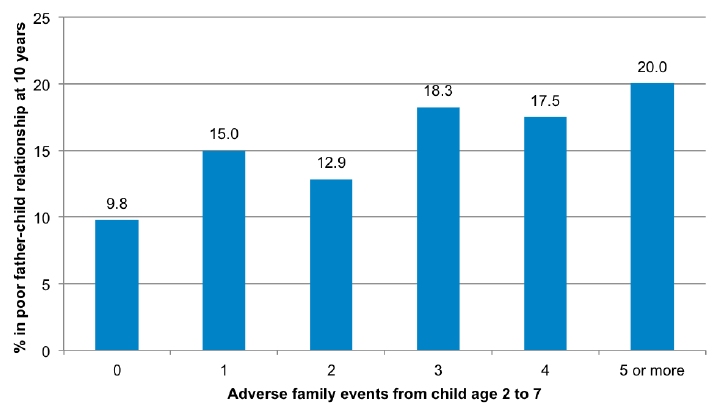
Note: Base sample of couples with both biological parents n=1,967 (unweighted). Trend is statistically significant p<0.05.
5.4.2 Child physical health and socio-emotional adjustment
Various measures of child physical health (general health, limiting long term illness, being overweight or obese) were considered: however, there is no association between measures of the child's physical health from age 3 onwards and the quality of the father-child relationship at age 10.
Child socio-emotional adjustment was measured from age 4 onwards using the Strengths and Difficulties Questionnaire ( SDQ) (Goodman, 1997; Goodman, 2001), administered to the child's main carer (almost always the mother) using a computer-assisted self-complete section of the age 10 main carer home interview. The total difficulties score is a sum of four 5-item subscales concerning emotional, conduct, hyperactivity/attentional and peer relationship problems. Items ask for agreement with statements concerning the child, with responses on a 3-point scale: (0) not true, (1) somewhat true, (2) certainly true. The total difficulties score ranges from 0 to 40: according to recommended practice, a cut-off score of 15 or more was used to indicate a "high" value corresponding to abnormal or borderline abnormal levels of problems. At age 4, 5.7% of children in the analysis sample were classified as having abnormal or borderline abnormal levels of behavioural and emotional problems. These children were more likely to have a poor relationship with their father at age 10 (25% did so, compared to 14% of other children, p<0.05). Similar associations between high levels of behavioural and emotional difficulties at child ages 5, 6 or 8 and increased risk of poor father-child relationship at age 10 were found.
5.4.3 Family climate
Two measures of family climate were considered: home organisation and supportive family ethos.
Home organisation was a standardised score using 3 items from the confusion, hubbub, and order scale (Matheny, Wachs, Ludwig & Phillips, 1995), Cronbach alpha=0.65. When the child was age 5, parents (in this analysis sample, always the child's mother) were asked for their agreement with the following statements: "It's really disorganised in our home", "You can't hear yourself think in our home" and "The atmosphere in our home is calm" (item reversed), using a 5-point scale (1=strongly disagree, to 5= strongly agree). Scores were banded into tertiles indicating weak, medium or strong home organisation.
Supportive family ethos was measured using eight items from the cohesion and disengagement subscales of a widely-used scale of family functioning (Bloom, 1985).
All items appeared to reflect the same underlying concept, as demonstrated by a factor analysis showing that they all loaded on to a single factor. Items had excellent internal reliability, Cronbach alpha=0.80. Parents (usually the child's mother) were contacted via a web/telephone survey when the child was aged 9 and asked for agreement with statements using a 5-point scale (1=strongly disagree, to 5= strongly agree). There were four positive statements ("Our family members really help and support one another", "In our family, we know where all the family members are at all times", "We really get along well with each other", "There is a feeling of togetherness in our family") and four negative statements that were reverse-coded ("It is difficult for me to keep track of what other family members are doing", "Our family members do not check with each other when making decisions", "Our family don't do things together", "Our family members seem to avoid contact with each other when at home"). Mean scores were calculated and banded into tertiles, indicating weak, medium and strong family supportiveness.
Figure 5-I shows that families with a strong home organisation or with strong family ethos were both less likely to contain children perceiving a poor relationship with their father, compared to families where these aspects of family climate were relatively weak.
Figure 5-I Associations between measures of family climate and father-child relationship
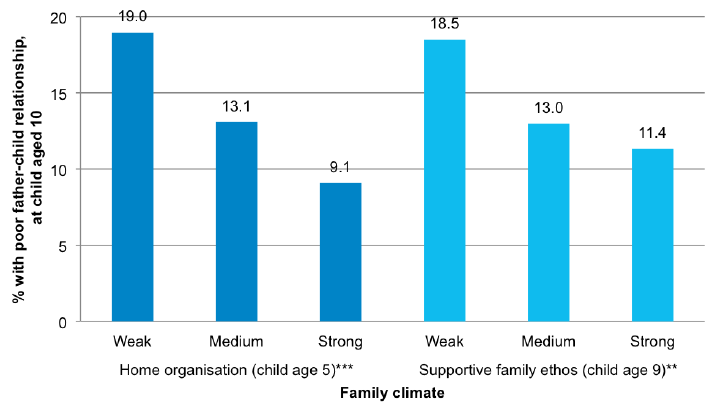
Note: Base sample of couples with both biological parents n=1,967 (unweighted). Asterisks show statistically significant associations ** p<0.01, *** p<0.001.
5.4.4 Positive parenting
When children were almost eight years old they were invited to report on positive parenting behaviours by their parents (engagement, monitoring and use of positive reinforcement), using five items from the short form Alabama Scale (Elgar, Waschbusch, Dadds & Sigvaldason, 2007), reliability Cronbach alpha 0.67. These items were: "My parents tell me if I behave well", "My parents play games or do other fun things with me", "My parents tell me when I have done something well", "My parents tell me when I'm doing a good job with something", "My parents check to make sure I'm doing OK". Responses were on a 4-point scale: (1) never (2) sometimes (3) often (4) always. Note that the child's reports were for both parents collectively: children did not provide separate information for fathers and mothers at this time point. The mean positive parenting score was 3.1, suggesting that children in the sample were generally perceiving high levels of positive reinforcement, monitoring and engagement from parents. Mean scores were grouped into tertiles, corresponding to low, medium and high levels of positive parenting.
Children perceiving high levels of positive parenting were less likely to have a poor relationship with their father two years later: only 10% did so, compared to 20% of those with low levels of positive parenting (Figure 5-J).
Figure 5-J Association between positive parenting and father-child relationship
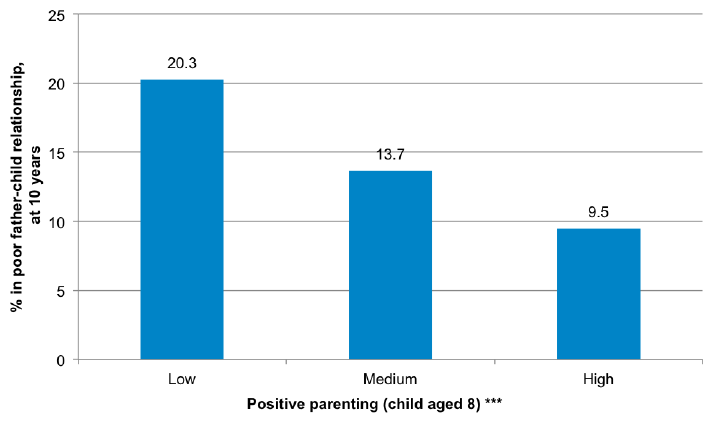
Note: Base sample of couples with both biological parents n=1,967 (unweighted). Asterisks show a statistically significant association, *** p<0.001
5.4.5 Multivariable model of early and later influences on father-child relationship
A multivariable model considered all early and pre-school/school-age factors found to have a statistically significant association with a poor father-child relationship.
In this model, multiple adverse family events, weak home organisation, low levels of positive parenting and weak family supportiveness all predict a poor father-child relationship by age 10. One indicator of family socio-economic disadvantage (low parental education) remain as a significant predictor of poor father-child relationship when the child was aged 10, as in the multivariable model considering only early life factors.
Comparing the results of the model of father-child relationships with a model of mother- child relationships, we find that poor mother-child relationships are not predicted by family climate, although adverse life events and less positive parenting are risk factors.
Further details of these models are provided in the Technical Annex.
Contact
Email: Wendy van der Neut
There is a problem
Thanks for your feedback